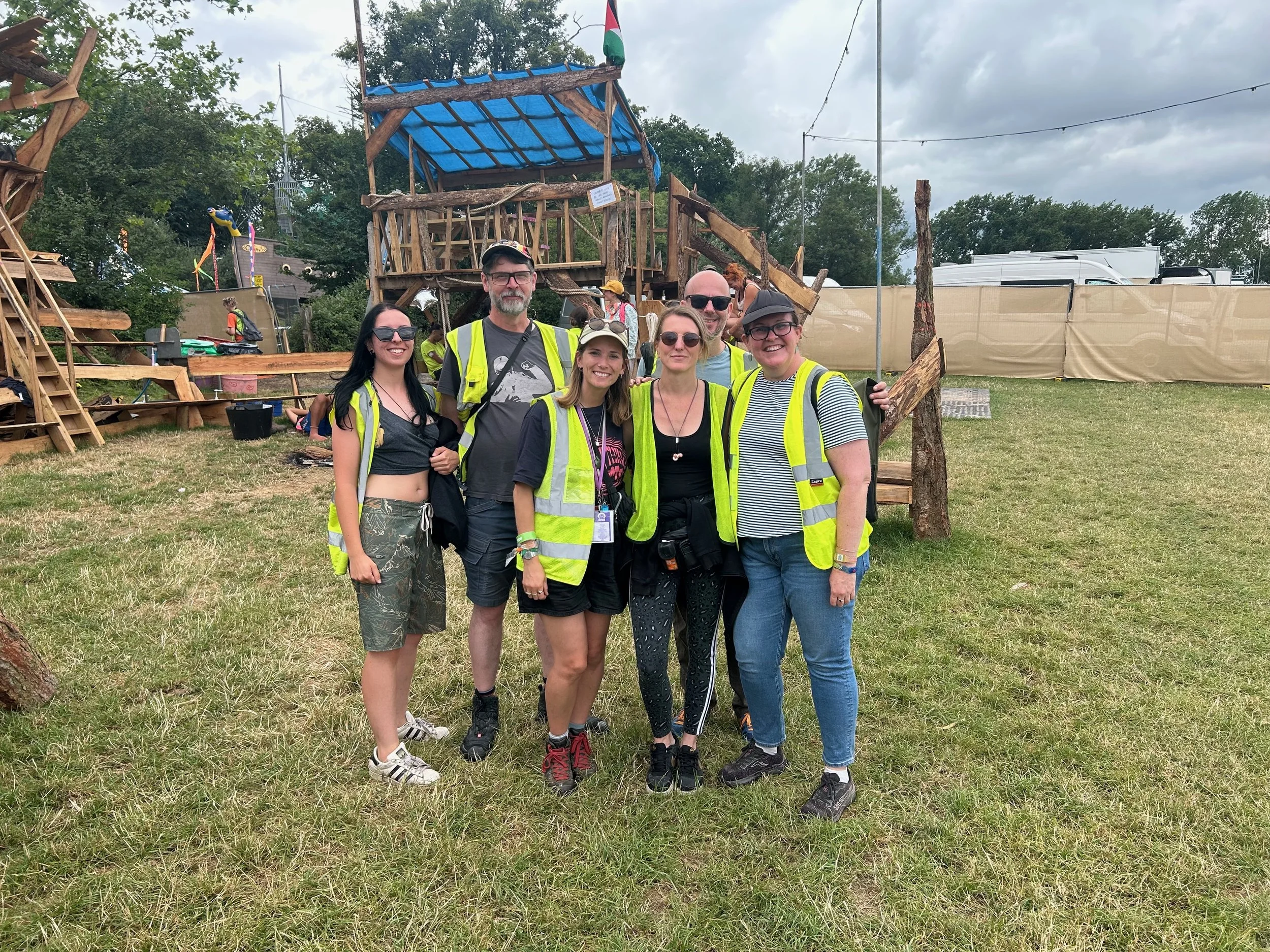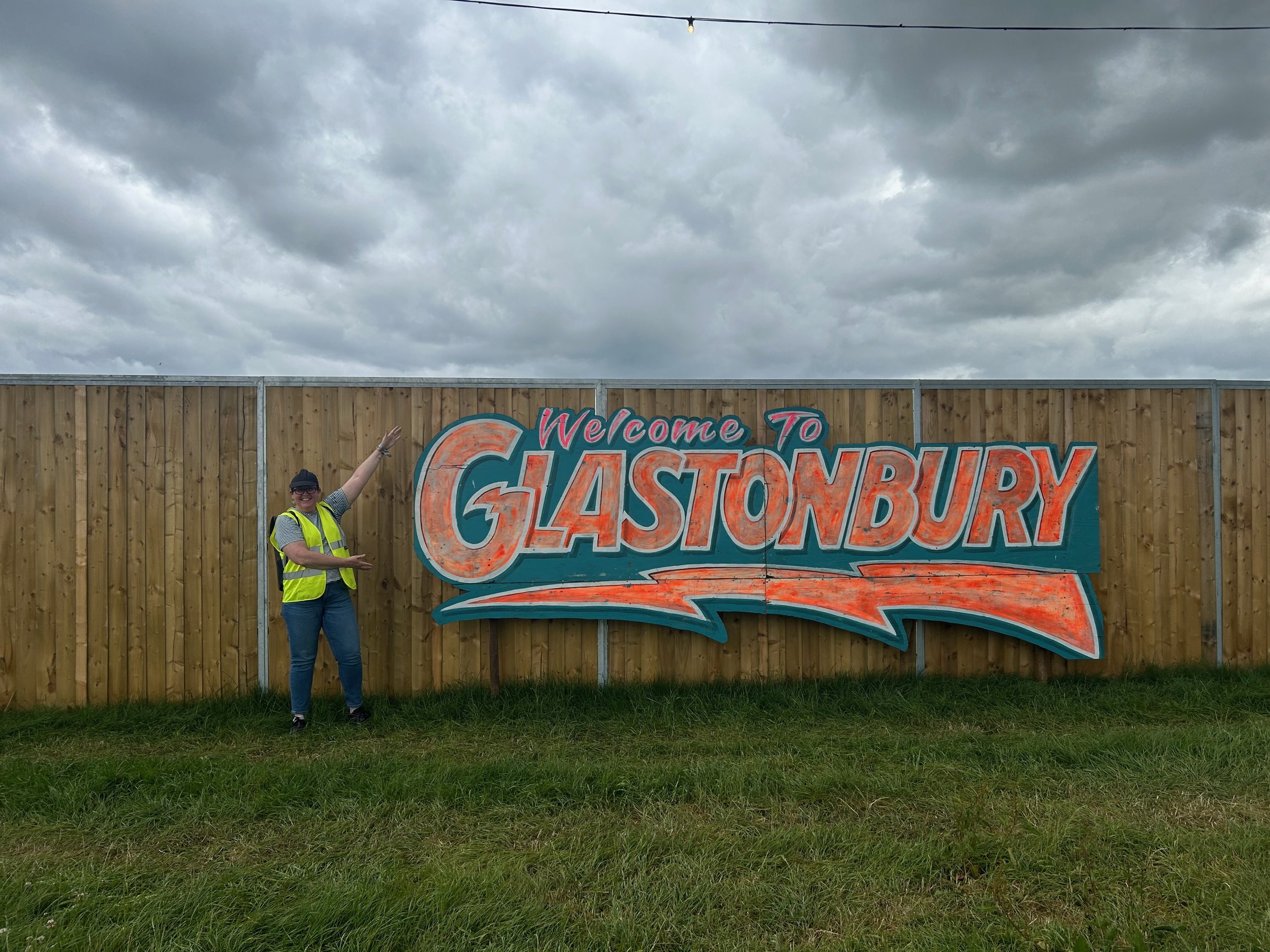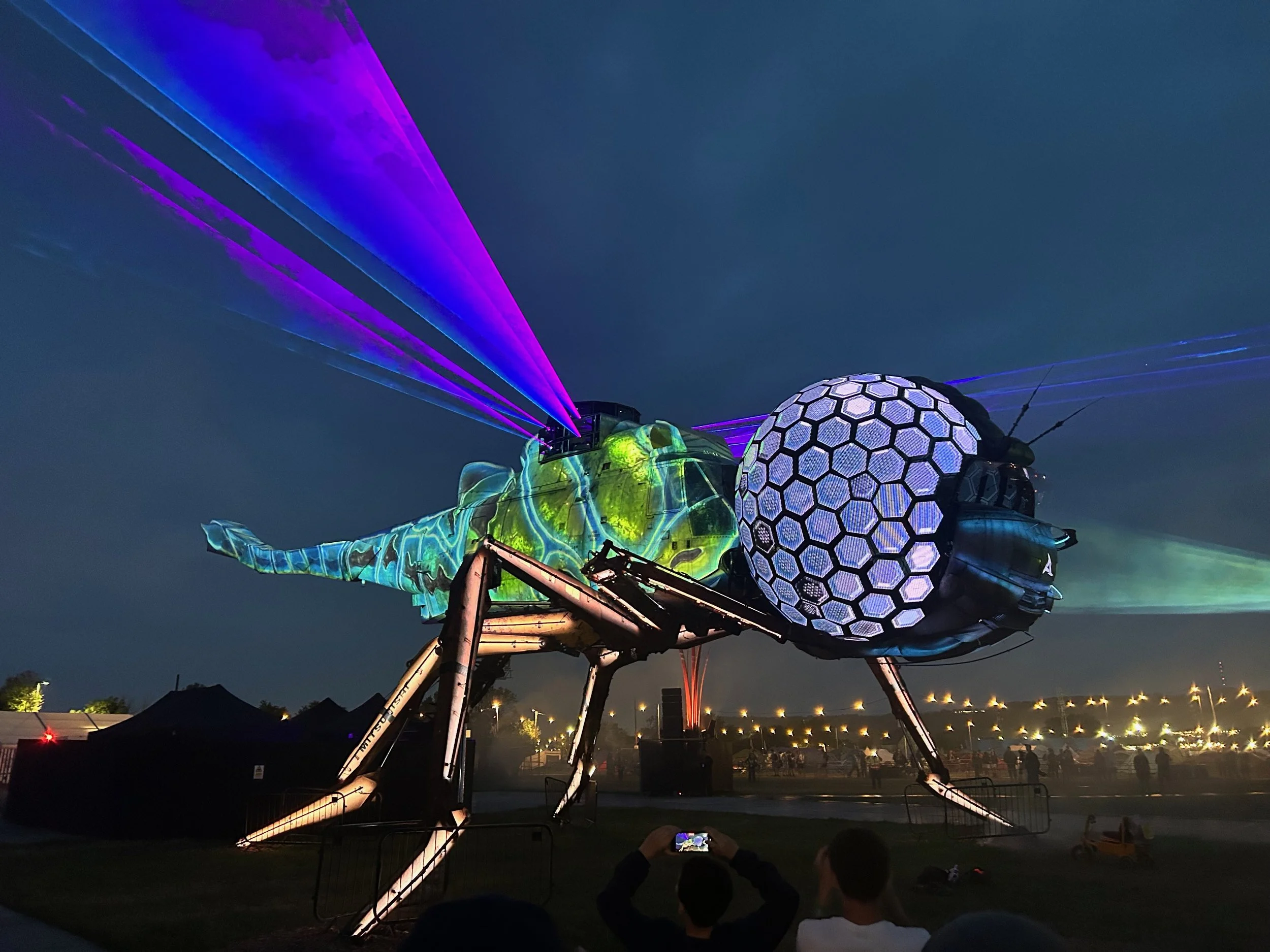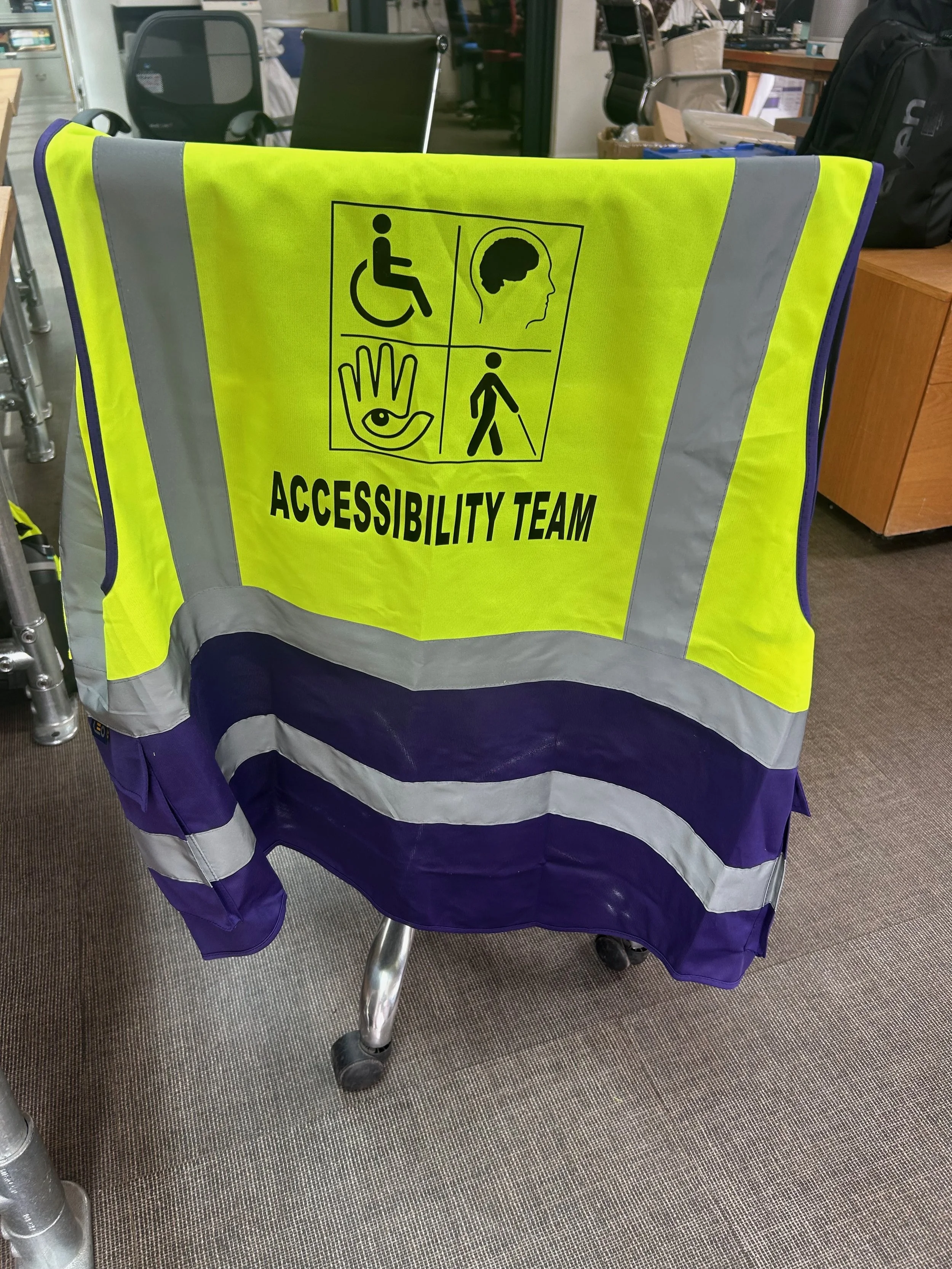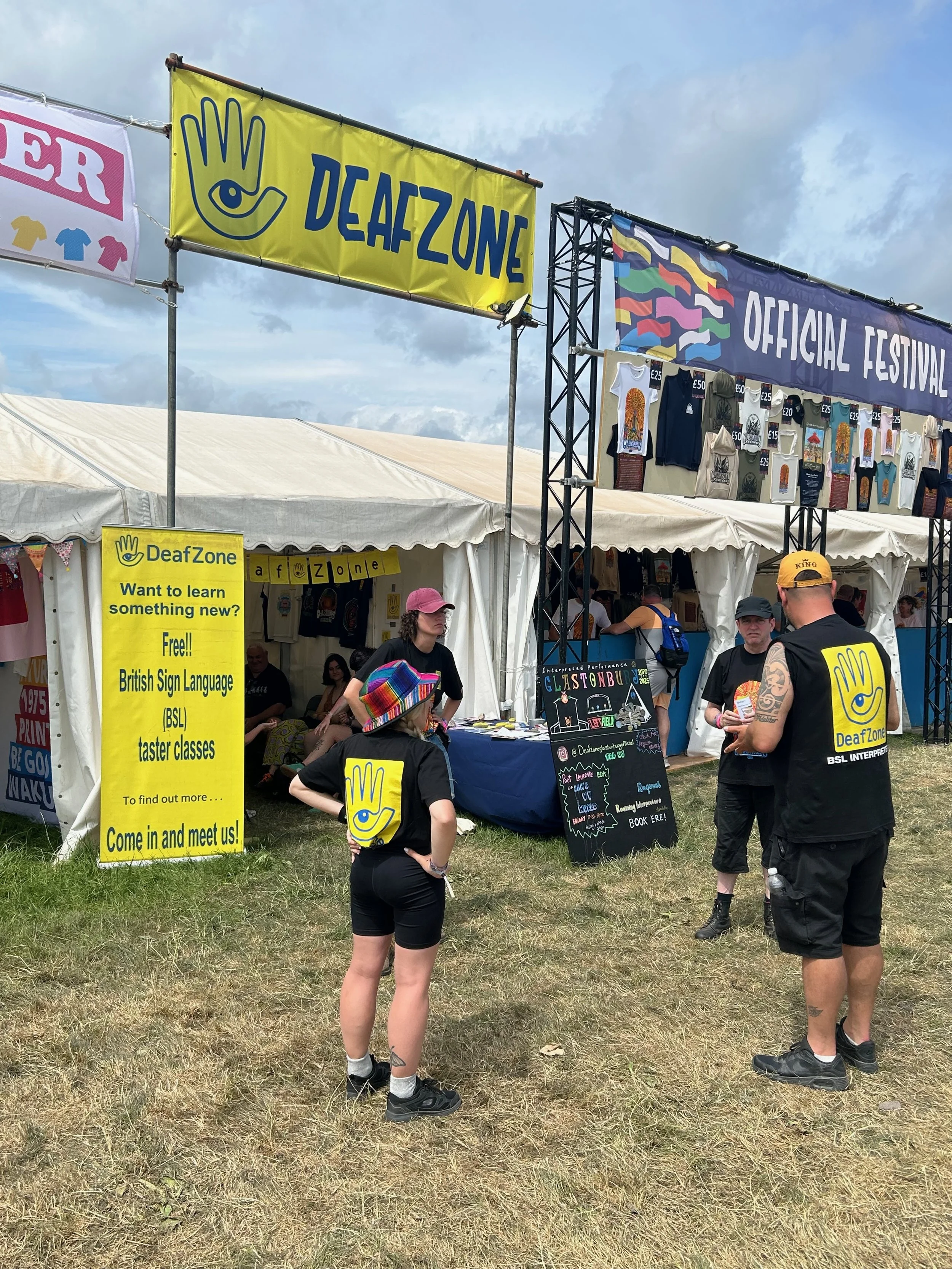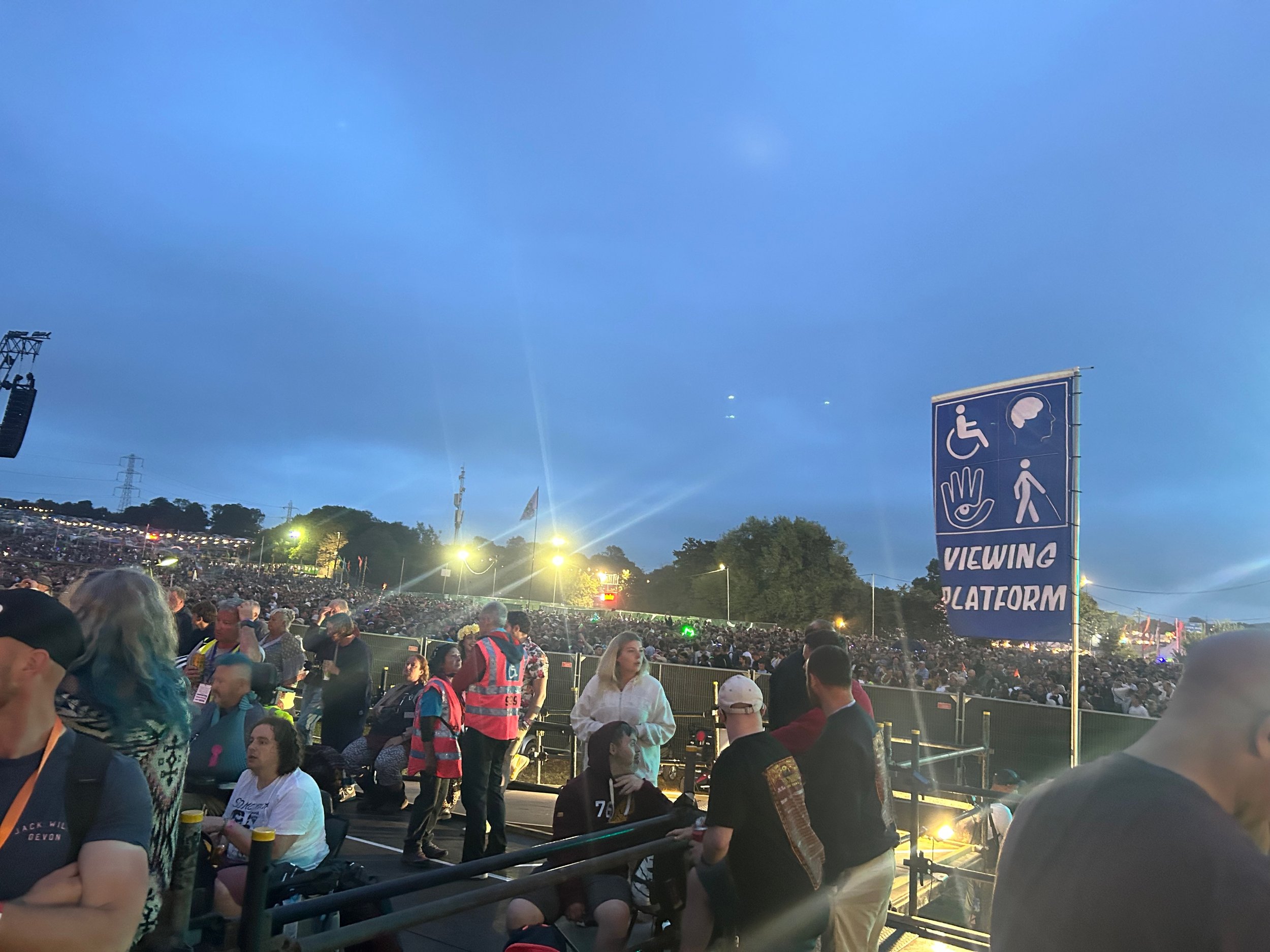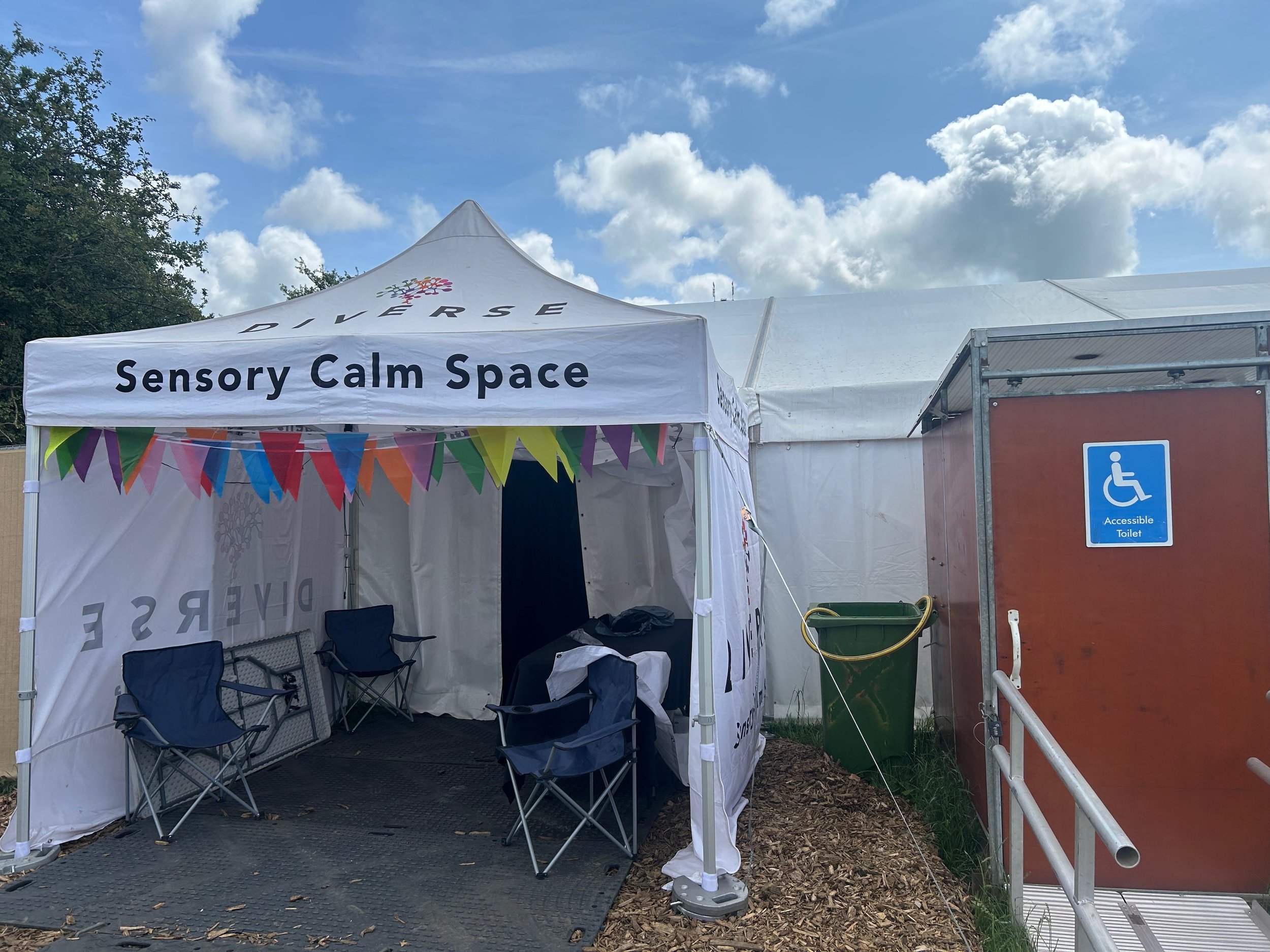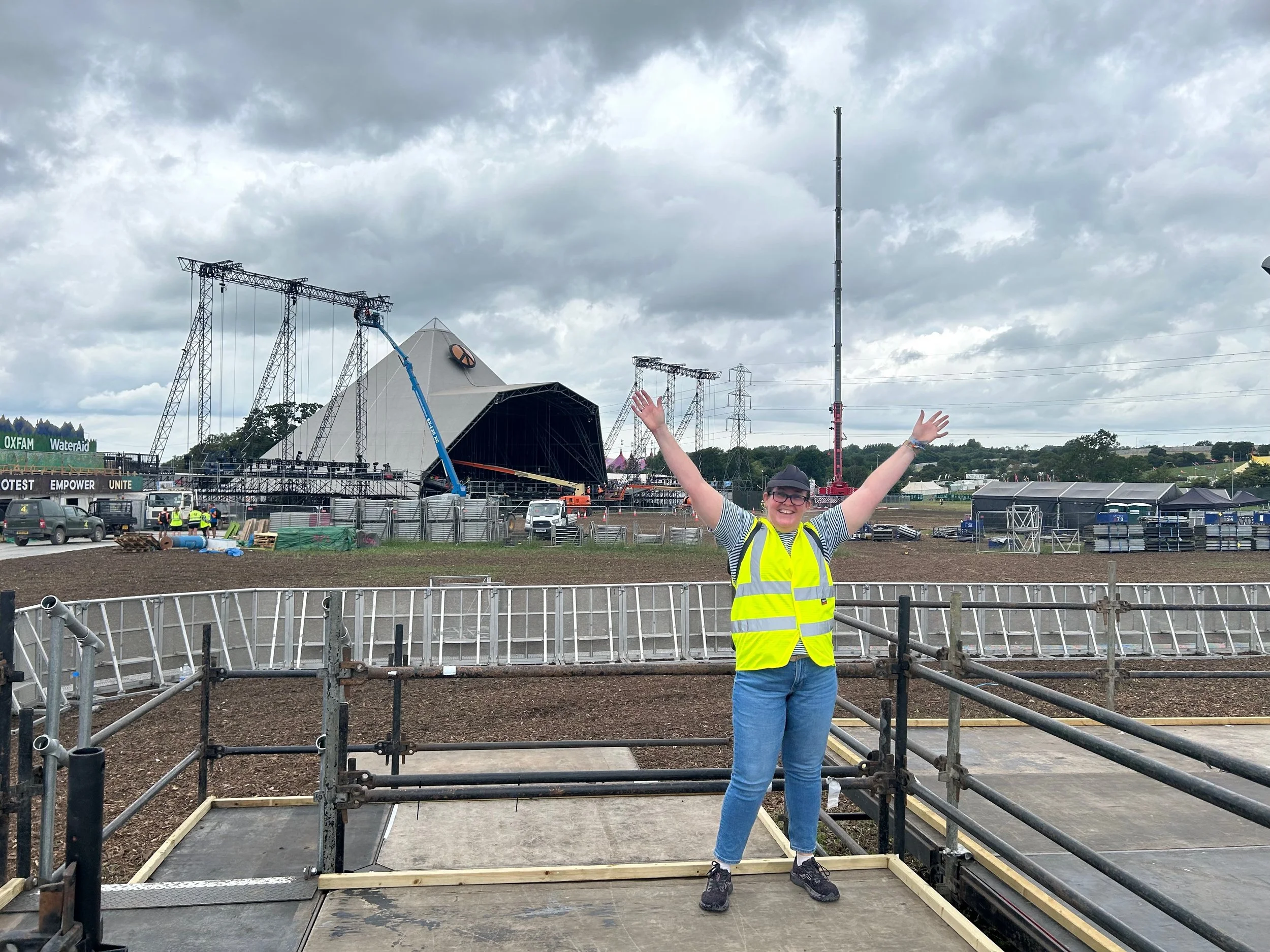Glastonbury - next level festival accessibility!
Written by Morwenna Collett
Image description: Morwenna and a small group in high visibility vests smiling, in front of a large wooden structure with platforms and stairs at Glastonbury Festival 2025.
Imagine a place full of amazing, disabled people. A place where we are everywhere - in front of, behind and on the stage. It’s fun, we’re represented, and it’s accessible.
Image description: Morwenna in a high visibility test next to a large sign saying ‘Welcome to Glastonbury’
Welcome to the Glastonbury Festival, the world’s largest music and arts festival on a greenfields site, which takes place in June in Pilton in Somerset, regional England. I recently had the pleasure of working at this amazing festival, thanks to support from Music Australia. I met their incredible Access Manager Claire Elsam 5 years ago and have been super keen to come back and experience the festival in action ever since. By being on the ground as a crew member, I got an incredible insight into seeing how they do accessibility on a challenging site (it’s on a farm, the cows go on holidays for a little while!) and at scale - Glastonbury becomes the seventh biggest city in the UK for the five days it takes place!
Image description: Night scene from a viewing platform across a sea of people to a huge stage, with many coloured lights and a big crowd.
1.The numbers
The festival has been run by diary farmer Michael Eavis and his family since 1970, for over 50 years now, and they’ve been doing accessibility work since 2005 - even before the UK had its Equalities Act (2010).
The site itself is over 1000 acres (the size of 500 soccer fields), with 120+ stages and over 3,500 performances. It’s organised into different areas, each of which are run and built by different companies and people, with a central administration that provides oversight and guidance around standards such as accessibility.
There are 205,000 people on-site, with 135,000 tickets selling out in under 33 minutes last November. It takes a crew of 65,000 people to make it all happen and local villagers and Sunday ticket holders make up another 5,000 people. In 2025, there were 1663 access customers (with 563 Personal Assistants) and 567 disabled crew/artists (with 253 Personal Assistants). That’s a lot of people!
Image description: Artwork ‘Arcadia Dragonfly’ made in collaboration with Wadjuk Noongar artists from Perth. A giant dragonfly sculpture glowing at night, covered in colourful lights with its wings as coloured light beams.
The high visibility vests worn by the access team.
2. The Access Team
To support all the accessibility for customers, crew and artists, there is a team of approximately 250 people, 50% of which are disabled themselves. The amazing Claire Elsam has been the festival’s Access Manager since 2007, and she works with and a team of 3 other access staff who work year round or for several months prior to the event, as well as additional paid staff managing the campsite and Access Stewards, and an additional 140 Access Stewards (who manage the accessible viewing platforms and accessible campsites) and their 40 odd Personal Assistants (like our Carers/companions). They also have a terrific Access Consultant, Andrew Lansley, who leads on crew and artist accessibility, a content team (who record accessible content to make things like video explainer guides and virtual tours) and there is also an Access Lead and Access Liaison positions for each area around the festival site.
In addition, Glastonbury works with many partners and organisations to deliver its access and inclusion work, including:
Attitude Is Everything, a brilliant music and live events peak body, who provide access auditing services across the festival site, making improvements as they go
Deafzone, who provide BSL interpreters for the three main stages and any other shows/events across the festival on a first come, first served basis. They also provide BSL lessons several times a day, open to anyone to sign up for.
Accessible Events, who set up and provide staffing support for the 5 sensory spaces across the site
Sighted Guides, who provide guided support for people who are Blind or low vision attending the site.
Give Vision, a company providing a wearable assistive technology headset, similar to a VR headset using a high-quality camera to capture the user’s surrounding environment and display an enhanced image inside the headset.
Image description: The DeafZone area and staff stand at Glastonbury. A big yellow banner, table with resources and a few staff with yellow logo on their backs standing around talking.
3. Access Provisions
A wide array of access services are provided online and on-site. One people get their hands on a ticket (the hard part!), customers who are registered with the UK’s Access Card scheme (run by Nimbus Disability) can apply to be part of the access programme and receive the appropriate type of access to meet their needs.
Pre-event
The festival is committed to making things as seamless as possible for its access customers, both before they arrive and once they’re there. Before the event, Glastonbury puts all its access information online with British Sign Language videos to walk you through it, and ticket holders receive a detailed Customer Access Guide so they know what to expect. There’s even an Arrivals Video that shows what it’s like to arrive, which is handy because getting on-site can be quite overwhelming. The car park opens at 9 p.m. the night before, and plenty of people camp out ready for the gates to open the next morning.
Once customers are inside, there are a few more tools to make everyone’s lives easier. There’s a map highlighting accessible routes and facilities and a mobile app for wayfinding and information. All of this helps make sure everyone can find their way around this massive site and enjoy the festival.
On-site access provisions
On site, a lot of thought goes into making the festival grounds as easy to navigate and enjoy as possible. Detailed information is available about the terrain and distances between areas, and miles of accessible trackway is laid to help visitors move around easily. To make viewing the acts more comfortable, Glastonbury offers twelve accessible viewing platforms and areas spread across the site, providing safe environments with clear sightlines to performances. Each platform is equipped with mobility scooter charging points, water and accessible toilets, and entry is managed by the Access Steward team and security staff. Customers need a specific type of access wristband to use these spaces, and several of them are paired with viewing areas designed for Deaf festival‑goers, with interpreters provided by Deaf Zone. There’s even a video guide to the platforms so people know what to expect in advance. There is a great video guide to accessible viewing platforms, to give customers an insight into what to expect.
Image description: A viewing platform at dusk with several people on the platform and access team in high visibility vests, and a huge crowd in the background.
Image description: Access area with a sign reading ‘Please ask if you require any assistance’.
Beyond the stages, a complimentary Personal Assistant ticket scheme helps those who need support, and over 180 accessible port‑a‑loos plus several portable adult change facilities are available across the site—almost all of the stock that’s available in the UK. Camping and mobility are equally well supported: several accessible campsites serve tents and campervans; mobility scooter hire helps visitors who may not be regular scooter users but require one to cover the festival’s long distances; and accessible car parking, shuttle buses and other transport options are in place. Structurally, the site considers access needs by providing features like lowered bar counters, and even wheelchair accessible bench seating. Deaf Zone coordinates British Sign Language interpreters for the main stages and runs free BSL lessons; assistive listening technology is available in many locations; captions are provided as part of the film programme; and sighted guides and audio description enhance experiences for blind and low‑vision visitors. For those needing a break from the bustle there are five sensory calm spaces—including one just for crew—as well as medical and welfare tents, plenty of water, and scooter charging points to keep everyone comfortable.
Image description: A sensory calm space marked ‘Diverse Sensory Calm Space’. A white small tent with chairs and colourful flags.
Accessible sessions and technology
This year, Glastonbury is introducing Accessibility Sessions at Glastonbury‑On‑Sea and Terminal 1 to give Deaf, disabled and neurodivergent festival‑goers a more relaxed experience. These sessions reduce crowds and sound levels and provide support from British Sign Language interpreters and sighted guides. Access wristband holders and their Personal Assistants or one companion will get priority entry to ensure the environment stays calm and inclusive. At the area called Terminal 1 (a wheelchair inaccessible 4 level structure), organisers created a new virtual experience exclusively for access customers, offering a fully seated, 15‑minute simulation of the space, with stewards on hand to guide participants.
Image description: 2 virtual reality headsets lying on a table at Terminal 1.
In addition to these sessions, Glastonbury is piloting wearable assistive technology for Blind and low vision attendees. At Pyramid Stage viewing platform 1, festival‑goers could use Give Vision headsets that function like virtual reality goggles, using a high‑quality camera to capture the surroundings and display an enhanced image that can be customised to suit individual sight profiles. This makes it easier to see faces and enjoy the theatrics on stage.
Accessible camping
Glastonbury offers dedicated camping areas for disabled festival‑goers and their companions, making it easier to stay on site comfortably. The Spring Ground Accessible Campsite is set aside for tents, while Wicket Ground Campsite is reserved for campervans, and both are equipped with accessible toilets, showers and adult change facilities. A campsite manager with lived experience of disability oversees these areas, and if you don’t have your own equipment you can even book a pre‑erected tent. Power supplies are available for those who need electricity, and mobility scooters can be hired and charged on site.
Access customers are welcome to bring along up to three people with them, including Personal Assistants, and there’s a well‑being tent offering massages and other relaxation services to help everyone unwind. A campsite office and an Access Steward office are located nearby to handle any queries or provide assistance during the event. Some of the other camping areas across and just outside the festival grounds also include access provisions, so visitors can choose the location that suits them best.
Access for crew and artists
Artists and crew members with access needs apply for access provisions through ahead of the event. A comprehensive Crew Access Guide outlines the services and accommodations available, and performers and crew can submit Access Riders detailing any specific adjustments or support they might need on-site. The festival is continuing to improve back‑of‑house accessibility, with many back-of-house structures being designed with access in mind and many of the stages also designed to be accessible. The festival has also been running accessible traineeships and programs within production and technical teams, and providing Disability Equality Training for many of their staff, helping to build a more inclusive festival industry.
A great example of the festival’s commitment to crew accessibility is its “Levelling the Field” initiative. Through its Diversity, Equity and Inclusion fund, Glastonbury supported a program to create meaningful opportunities for disabled people in the festival environment, run by The Rum Shack venue. This program trained a group of disabled participants in event production and they then took over the area on selected evenings, running everything from the stage to the front‑of‑house. This initiative not only offered hands‑on experience but also demonstrates how inclusive practices can be integrated into live events. There’s a great video on this initiative available here.
4. Key take-aways
Festival strengths
One of Glastonbury’s key strengths in accessibility is that it has established a dedicated role focused on inclusion and kept the same person in that position over many years, providing continuity and a deep understanding of the festival’s evolving needs. This role is informed by lived experience, drawing on input from an Access Consultant and other members of the disabled community, which helps build a supportive network and a community of practice that shares ideas and solutions. The festival also produces an Access Toolkit that gathers good practice examples from different areas of the event, enabling organisers and partners to learn from each other and continually improve their approach to making the site welcoming for everyone.
Disability representation
Glastonbury has made notable strides in disability representation by spotlighting disabled artists and addressing disability issues across its programming. The festival’s opening ceremony included disabled performers, and acts with disabled artists appeared on many stages, including the main stages, with production teams ensuring that accessible provisions were in place for both crew and artists. Beyond music, the talks programme was adjusted to feature a session on the UK government’s disability cuts, giving these issues a platform in front of festival audiences. Highlights such as Lewis Capaldi’s set—he is open about his experiences with Tourette syndrome—further underscored the festival’s commitment to inclusive representation.
Festival challenges
Despite its many access achievements, the nature of the festival environment itself means Glastonbury faces some challenges. The festival is staged on a greenfield site, so rain and mud can undermine even the best laid paths and platforms, and different areas are constructed by third‑party providers, which makes it harder to maintain consistent standards across the entire site. Because of the number of access features (like accessible toilets) available on-site, they also have to have a timeline to apply for access services by, to be able to manage capacity. This can be tricky for any last-minute additions to line-up or crew.
5. What’s next?
Being at Glastonbury was truly one of the most accessible experiences of my life. It was a window into what the future of festivals could look like, if we all prioritised care, safety and the well-being of everyone in our community.
Image description: Morwenna in high visibility vest smiling with her arms in the air on a raised platform in front of a stage being built.
One of the best things about Glastonbury’s access program is that they are really into continuous improvement. They are constantly thinking about how they can do things better and be able to offer more access. Next year will be a follow (off) year for the festival, to let the site recover and rejuvenate again. But I can’t wait to see what they’ll be back with in 2027!

